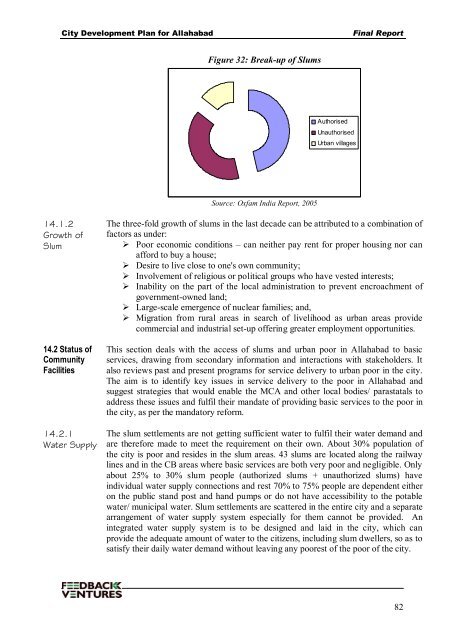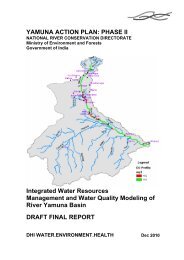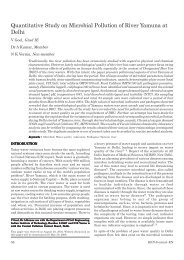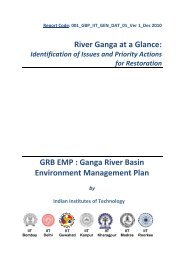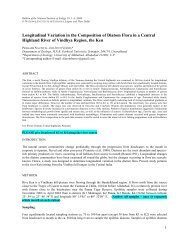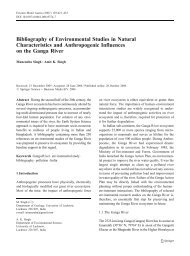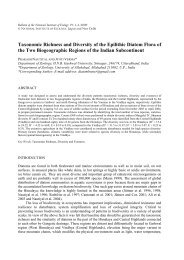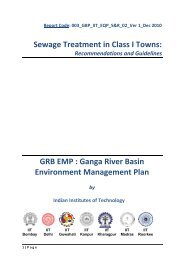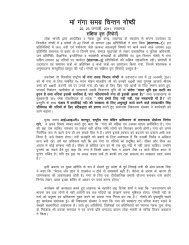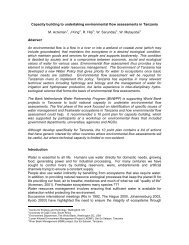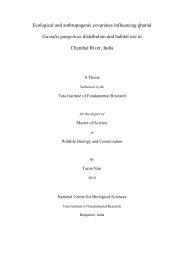Contents - GANGAPEDIA
Contents - GANGAPEDIA
Contents - GANGAPEDIA
Create successful ePaper yourself
Turn your PDF publications into a flip-book with our unique Google optimized e-Paper software.
City Development Plan for Allahabad Final Report<br />
14.1.2<br />
Growth of<br />
Slum<br />
14.2 Status of<br />
Community<br />
Facilities<br />
14.2.1<br />
Water Supply<br />
Figure 32: Break-up of Slums<br />
Source: Oxfam India Report, 2005<br />
Authorised<br />
Unauthorised<br />
Urban villages<br />
The three-fold growth of slums in the last decade can be attributed to a combination of<br />
factors as under:<br />
Poor economic conditions – can neither pay rent for proper housing nor can<br />
afford to buy a house;<br />
Desire to live close to one's own community;<br />
Involvement of religious or political groups who have vested interests;<br />
Inability on the part of the local administration to prevent encroachment of<br />
government-owned land;<br />
Large-scale emergence of nuclear families; and,<br />
Migration from rural areas in search of livelihood as urban areas provide<br />
commercial and industrial set-up offering greater employment opportunities.<br />
This section deals with the access of slums and urban poor in Allahabad to basic<br />
services, drawing from secondary information and interactions with stakeholders. It<br />
also reviews past and present programs for service delivery to urban poor in the city.<br />
The aim is to identify key issues in service delivery to the poor in Allahabad and<br />
suggest strategies that would enable the MCA and other local bodies/ parastatals to<br />
address these issues and fulfil their mandate of providing basic services to the poor in<br />
the city, as per the mandatory reform.<br />
The slum settlements are not getting sufficient water to fulfil their water demand and<br />
are therefore made to meet the requirement on their own. About 30% population of<br />
the city is poor and resides in the slum areas. 43 slums are located along the railway<br />
lines and in the CB areas where basic services are both very poor and negligible. Only<br />
about 25% to 30% slum people (authorized slums + unauthorized slums) have<br />
individual water supply connections and rest 70% to 75% people are dependent either<br />
on the public stand post and hand pumps or do not have accessibility to the potable<br />
water/ municipal water. Slum settlements are scattered in the entire city and a separate<br />
arrangement of water supply system especially for them cannot be provided. An<br />
integrated water supply system is to be designed and laid in the city, which can<br />
provide the adequate amount of water to the citizens, including slum dwellers, so as to<br />
satisfy their daily water demand without leaving any poorest of the poor of the city.<br />
82


